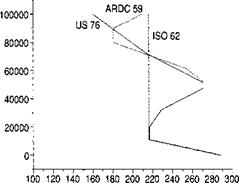Subsystem Models
8.2.1 Atmosphere
Without atmosphere, life on Earth would be miserable. I particularly appreciate the 21% of oxygen mixed in with 78% of nitrogen and 1% of argon and carbon dioxide. For engineers the atmosphere has other important attributes like density, temperature, and pressure that affect the trajectory of an aerospace vehicle. Air density determines the aerodynamic forces and moments, temperature is linked to the speed of sound, and air pressure modulates the thrust of a rocket engine.
Air temperature changes with altitude, but it does not consistently decrease with greater heights. Discrete changes in its gradient are used to divide the atmosphere into several layers. The troposphere, characterized by a decreasing temperature gradient, reaches from sea level up to 11 km, followed by the tropopause region with constant temperature until 20 km. From then on, in the stratosphere the temperature increases first as a result of the absorption of infrared radiation from Earth and solar ultraviolet radiation and then decreases. Its upper boundary at 80 km coincides with the somewhat arbitrary upper limit of the endo-atmosphere, above which the density is so low that it cannot deliver any significant aerodynamic lift. Beyond the stratosphere lies the exo-atmosphere, characterized by the dissociation of oxygen and ionization of nitrogen. In that region, also called the thermosphere, the temperature increases more strongly until 400 km, where the free-path lengths between molecules and atoms are so large that the definition of temperature becomes meaningless.
Much effort has been invested exploring the atmosphere. In 1955, President Eisenhower proclaimed the International Geophysical Year, which focused on upper atmospheric research with sounding rockets. Many measurements were taken and distilled into so-called standard atmospheres. The 1959 ARDC (Air Research Development Command)2 atmosphere was used exclusively for many years until it was supplemented by the U. S. Standard Atmosphere in 1976.3
For simulations that do not require high fidelity, or are limited to the lower regions of the atmosphere, simple functions are used. For the three-DoF simulations of this chapter and the five-DoF simulations of Chapter 5, we use the 1962 International Standard Atmosphere or ISO 2533, summarized here.
Troposphere (altitude H < 11 km):
Temperature (°K) T = 288.15 – 0.0065Я
![]()
![]() 5.2559
5.2559
where H is in meters.
Tropopause-stratosphere (altitude 11km < H < 80 km):
Temperature (°K) T = 216
Pressure (Pa) p = 22630е^0 000157б9(я_11000)
where H is in meters.
Endo-atmosphere (altitude 0 km < H < 80 km):
, p
Density (kg/nr) p = — Kl
Sonic speed (m/s) a — *JyRT
|
Dynamic pressure: |
|
|
Mach number: |
m=v- a |
Temperature and pressure are the primary variables, approximated by functions, whereas density is derived from the perfect gas law (R gas constant) and sonic speed from the adiabatic flow formula (y = 1.4 ratio of specific heat for air).
The three atmospheres are almost indistinguishable in the troposphere. Only in the stratosphere do we see differences in temperature (see Fig. 8.2), whereas density and pressure are already so low that any distinction is washed out. The ARDC atmosphere is used in space ascent and hypersonic vehicle simulations that require high fidelity, e. g., the CADAC GHAME6 six-DoF model. The U. S. 76 atmosphere is recommended for in-atmosphere and stratosphere simulations that do not exceed 86 km altitude. You find it implemented in the CADAC FALCON6 simulation.
Standard atmospheres are useful for comparative trajectory studies, but, of course, no airplane ever encounters it. There is so much seasonal and diurnal variability that any exhaustive analysis should include an atmospheric sensitivity study. You can consult the literature, like the Handbook of Geophysics,4 and
|
Altitude meter
Temperature °K Fig. 8.2 Comparison of standard atmospheres. |
find the so-called hot and cold atmospheres at various latitudes—the CADAC weather deck allows you to enter them in tabular form. Or, because the U. S. 76 atmosphere is normalized to standard sea-level conditions, you simply change the sea-level values for temperature, pressure, and density and build your own generic variations.












